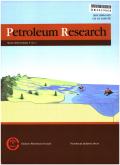脂肪烃组分有机地球化学特征对Sawahlunto和Sangatta煤煤层气勘探策略的指导意义
IF 4
Q1 Earth and Planetary Sciences
引用次数: 0
摘要
分析了Sawahlunto (SL-02)和Sangatta (KD-04)煤中脂肪烃组分生物标志物的存在,评价了它们的有机地球化学特征及其对煤层气勘探策略选择的意义。采用气相色谱-质谱(GC-MS)方法进行结构鉴定,发现了正构烷烃、类异戊二烯、倍半萜和三萜的分布。两种煤样有机质均来源于高等陆源植物,表现为长链正构烷烃占主导地位,碳偏好指数(CPI)大于1,低碳偏好指数(LHCPI)小于1,陆源/水生比(TAR)大于5,8β(H)-同驱物占主导地位,8β(H)-同驱物占主导地位。Pr/Ph值大于1,存在藿烷(C31和C32),且8β(H)-drimane丰度较低,表明两样品为缺氧沉积环境。CPI值大于1,OEP值大于1,LHCPI值小于1,17α(H),21β(H)-高藿烷(22S)的丰度与17α(H),21β(H)-高藿烷(22R)的丰度相比,KD-04样品中夹竹桃烯-12烯,夹竹桃烯-18烯和新啤酒花-13(18)-烯等不饱和生物标记物的存在表明煤相对不成熟。Hunt图中Pr/n-C17比值与Ph/n-C18比值的交点图将样品分类为源自高等陆源植物的腐殖质煤,沉积于氧化环境中,并且在SL-02和KD-04煤中都具有生气潜力,为III型油根。这些生物标志物数据和参数与西苏门答腊Sawahlunto煤矿的SL-02煤和东加里曼丹Sangatta煤矿的KD-04煤的甲烷气矿工高度相关。CBM估计有生物成因。本文章由计算机程序翻译,如有差异,请以英文原文为准。
Organic geochemical aspects of aliphatic hydrocarbon fractions for determining coal bed methane exploration strategies of Sawahlunto and Sangatta coals
Sawahlunto (SL-02) and Sangatta (KD-04) coals were analyzed for the presence of aliphatic hydrocarbon fraction biomarkers to assess their organic geochemistry and its implications for selecting exploration strategies for coal bed methane (CBM). Structural identification using the gas chromatography–mass spectrometry (GC–MS) method revealed the distribution of n-alkanes, isoprenoids, sesquiterpenoids, and triterpenoids. The organic matter in both coal samples originated from higher terrigenous plants, as indicated by the dominance of long-chain n-alkanes, carbon preference index (CPI) values greater than 1, low vs. high carbon preference index (LHCPI) values less than 1, terrigenous/aquatic ratio (TAR) values over 5, and the dominance of 8β(H)-homodrimane over 8β(H)-drimane. An oxic depositional environment is suggested by a Pr/Ph ratio greater than 1, the presence of hopanes (C31 and C32), and the low abundance of 8β(H)-drimane in both samples. CPI values greater than 1, OEP values greater than 1, LHCPI values less than 1, the abundance of 17α(H),21β(H)-homohopane (22S) compared with that of 17α(H),21β(H)-homohopane (22R), and the presence of several unsaturated biomarkers in the KD-04 sample, such as olean-12-ene, olean-18-ene, and neohop-13(18)-ene, indicate that the coal is relatively immature. A cross plot of the Pr/n-C17 ratio against the Ph/n-C18 ratio in the Hunt diagram classifies the sample as humic coal derived from higher terrigenous plants, deposited in an oxic environment, and as a type III kerogen with gas-generating potential in both the SL-02 and KD-04 coals. These biomarker data and parameters are highly relevant for methane gas miners in SL-02 coal from the Sawahlunto coal mine, West Sumatra, and KD-04 coal from the Sangatta coal mine, East Kalimantan. The CBM is estimated to have a biogenic origin.
求助全文
通过发布文献求助,成功后即可免费获取论文全文。
去求助
来源期刊

Petroleum Research
Earth and Planetary Sciences-Geology
CiteScore
7.10
自引率
0.00%
发文量
90
审稿时长
35 weeks
 求助内容:
求助内容: 应助结果提醒方式:
应助结果提醒方式:


